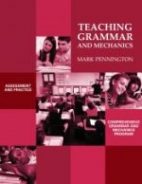Common Core Curricular Crossover
The Common Core State Standards (CCSS) produces some interesting curricular crossover. The traditional English-language arts divisions of reading, writing, listening, and speaking have been replaced with four new strands: reading, writing, speaking and listening, and language. The six Standards of the Language Strand borrow a bit from each of the traditional divisions.
CCSS L.1 and 2 are titled “Language Conventions.” They include grammar, mechanics, and spelling which have traditionally been listed in the writing division. Despite the assurances from the Common Core collaborators that conventions should not be divorced from the communicative context, many anti-direct instruction of grammar are suffering heart palpitations now that these conventions stand on their own in the Common Core.
CCSS L.3 is titled “Knowledge of Use.” Essentially, these grade-level standards deal with language application and have traditionally belonged within the writing, listening, and speaking divisions.
CCSS L.4, 5, and 6 are titled “Vocabulary Acquisition and Use.” These standards have traditionally been placed within the reading division. They include multiple meaning words and context clues (L.4.a.), Greek and Latin Word Parts (L.4.a.), Language Resources (L.4.c.d.), Figures of Speech (L.5.a.), Word Relationships (L.5.b.), Connotations (L.5.c.), and Academic Language Words (L.6.0).
Here is how the CCSS document summarizes the Language Strand:
The Language standards include the essential “rules” of standard written and spoken English, but they also approach language as a matter of craft and informed choice among alternatives. The vocabulary standards focus on understanding words and phrases, their relationships, and their nuances and on acquiring new vocabulary, particularly general academic and domain-specific words and phrases.
One unique feature of the Language Strand is the “Language Progressive Skills” document. Perhaps recognizing the cyclical nature of language instruction and the value of differentiated instruction, the document specifies certain L. 1 and 2 Standards for “special attention” and “review.”
The CCSS document summarizes the purpose of the “Language Progressive Skills”: The following skills, marked with an asterisk (*) in Language standards 1–3, are particularly likely to require continued attention in higher grades as they are applied to increasingly sophisticated writing and speaking.
*****
I’m Mark Pennington, author of the full-year interactive grammar notebooks, grammar literacy centers, and the traditional grade-level 4, 5, 6, 7, 8 and high school Teaching Grammar and Mechanics programs. Teaching Grammar and Mechanics includes 56 (64 for high school) interactive language conventions lessons, designed for twice-per-week direct instruction in the grade-level grammar, usage, and mechanics standards. The scripted lessons (perfect for the grammatically-challenged teacher) are formatted for classroom display. Standards review, definitions and examples, practice and error analysis, simple sentence diagrams, mentor texts with writing applications, and formative assessments are woven into every 25-minute lesson. The program also includes the Diagnostic Grammar, Usage, and Mechanics Assessments with corresponding worksheets to help students catch up, while they keep up with grade-level, standards-aligned instruction.
Or why not get the value-priced Grammar, Mechanics, Spelling, and Vocabulary (Teaching the Language Strand) grades 4, 5, 6, 7, and 8 BUNDLES? These grade-level programs include both teacher’s guide and student workbooks and are designed to help you teach all the Common Core Anchor Standards for Language. In addition to the Teaching Grammar and Mechanics program, each BUNDLE provides weekly spelling pattern tests and accompanying spelling sort worksheets (L.2), 56 language application opener worksheets (L.3), and 56 vocabulary worksheets with multiple-meaning words, Greek and Latin word parts, figures of speech, word relationships with context clue practice, connotations, and four square academic language practice (L.4, 5, and 6). Comprehensive biweekly unit tests measure recognition, understanding, and application of the grammar, mechanics, and vocabulary components.
The program also has the resources to meet the needs of diverse learners. Diagnostic grammar, usage, mechanics, and spelling assessments provide the data to enable teachers to individualize instruction with targeted worksheets. Each remedial worksheet (over 200 per program) includes independent practice and a brief formative assessment.
Check out the brief introductory video and enter DISCOUNT CODE 3716 at check-out for 10% off this value-priced program. We do sell print versions of the teacher’s guide and student workbooks. Contact mark@penningtonpublishing.com for pricing. Read what teachers are saying about this comprehensive program:
The most comprehensive and easy to teach grammar, mechanics, spelling, and vocabulary program. I’m teaching all of the grade-level standards and remediating previous grade-level standards. The no-prep and minimal correction design of this program really respects a teacher’s time. At last, I’m teaching an integrated program–not a hodge-podge collection of DOL grammar, spelling and vocabulary lists, and assorted worksheets. I see measurable progress with both my grade-level and intervention students. BTW… I love the scripted lessons!
─Julie Villenueve
The author also provides these curricular “slices” of the Grammar, Mechanics, Spelling, and Vocabulary “pie”: the five Common Core Vocabulary Toolkits Grades 4−8 and the five Differentiated Spelling Instruction Grades 4−8 programs.

